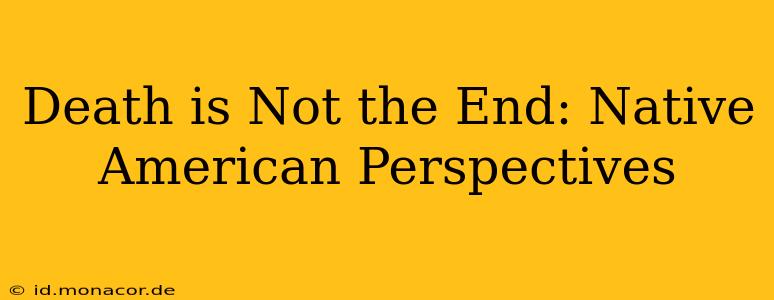Death, a universal experience, holds diverse meanings across cultures. In many Native American traditions, death isn't viewed as an absolute end but rather a transition, a continuation of the life cycle, and a homecoming. This perspective, deeply rooted in spirituality and interconnectedness with nature, offers a rich and nuanced understanding of mortality vastly different from mainstream Western thought. This article delves into various Native American beliefs about death, exploring the afterlife, funeral rites, and the enduring legacy of those who have passed.
What Happens After Death in Native American Cultures?
The concept of an afterlife varies significantly among the hundreds of distinct Native American tribes and nations. There isn't a single, unified belief system. However, common themes emerge, emphasizing a cyclical view of life and death. Many believe in a spirit world, often described as a place of ancestors, where the deceased join their loved ones and continue their existence in a different form. This spirit world might be located in a specific geographical location, such as a sacred mountain or a beautiful land beyond the physical realm.
Some tribes believe in reincarnation, where the spirit is reborn into another human or animal, continuing the cycle of life. Others envision a journey to the spirit world guided by ancestral spirits or other supernatural beings. The experience after death is often understood as a continuation of relationships and responsibilities, with the deceased maintaining connections to the living.
What are Traditional Native American Funeral Rites?
Funeral rites vary significantly between tribes, reflecting diverse cultural practices and beliefs. However, several common elements often appear. The body is often prepared with great care and respect, reflecting the belief in the sacredness of the individual, even in death. Mourning rituals may involve ceremonies, songs, dances, and storytelling, providing a space for community grieving and remembrance. These ceremonies serve not only to honor the deceased but also to support the living in their grief and to help them navigate the transition. Elaborate burials, often including grave goods significant to the deceased's life, are common in many tribes.
Do Native American Beliefs About Death Differ from Western Perspectives?
Yes, significantly. Western cultures often emphasize a linear view of life—birth, life, death—with death seen as a definitive end. Native American beliefs often embrace a cyclical view, seeing death as a transition to another realm or a rebirth into a new life. The focus is frequently on maintaining connections with the ancestors and honoring their legacy, rather than solely mourning the loss. Western culture may emphasize individual achievement, while many Native American traditions prioritize community and collective well-being, extending even into the afterlife. This fundamental difference in worldview significantly shapes the perspectives on death and dying.
What is the significance of ancestor veneration in Native American cultures?
Ancestor veneration plays a crucial role in many Native American cultures. Ancestors are viewed not as merely figures from the past but as continuing members of the community, offering guidance and protection to the living. Their spirits are believed to be present and influential in daily life, and honoring them is considered essential for maintaining balance and well-being. Many ceremonies and rituals are dedicated to maintaining these connections, ensuring the continuity of cultural practices and wisdom. This deep respect for ancestors underlines the cyclical view of life and death, reinforcing the belief that life continues beyond the physical realm.
How are Native American death rituals different from other cultures?
Native American death rituals vary greatly among the many tribes and nations, making generalizations challenging. However, some common differences from other cultures include the emphasis on community involvement in the mourning process; the importance of honoring the deceased’s spirit and ensuring their comfortable journey to the afterlife; and the incorporation of storytelling, songs, and dances that celebrate the life and contributions of the departed. Many rituals emphasize the continuity of life, rather than focusing solely on the finality of death. The practices are frequently tied to the natural world, reflecting the deep spiritual connection many tribes have with their environment.
Are there any common symbols associated with death in Native American traditions?
The symbols associated with death and the afterlife vary greatly across different Native American tribes. However, certain recurring motifs appear, often reflecting the specific spiritual beliefs and natural environment of a particular group. These could include animals considered sacred messengers between the worlds, celestial bodies such as the sun or moon representing cycles of life and death, and specific plants or natural elements that hold spiritual significance. Interpretations of these symbols are often rich with cultural and historical context, highlighting the interconnectedness of life, death, and the spiritual realm.
This exploration offers only a glimpse into the rich tapestry of Native American perspectives on death. The diversity of beliefs and practices across numerous tribes underscores the importance of understanding each culture’s unique traditions and honoring their perspectives on this profoundly human experience. Further research into specific tribal cultures will provide a deeper appreciation for the complexity and beauty of these enduring worldviews.

